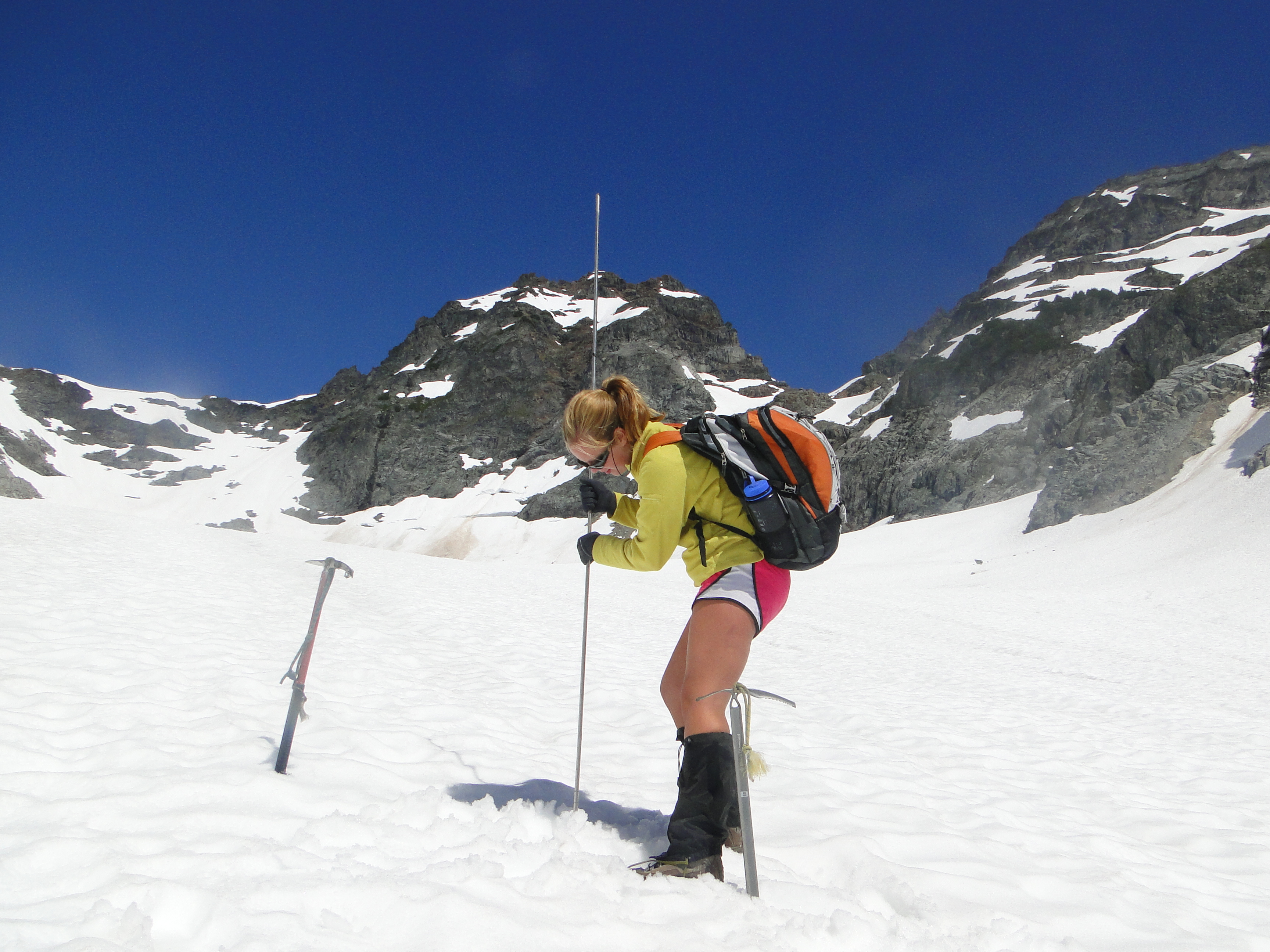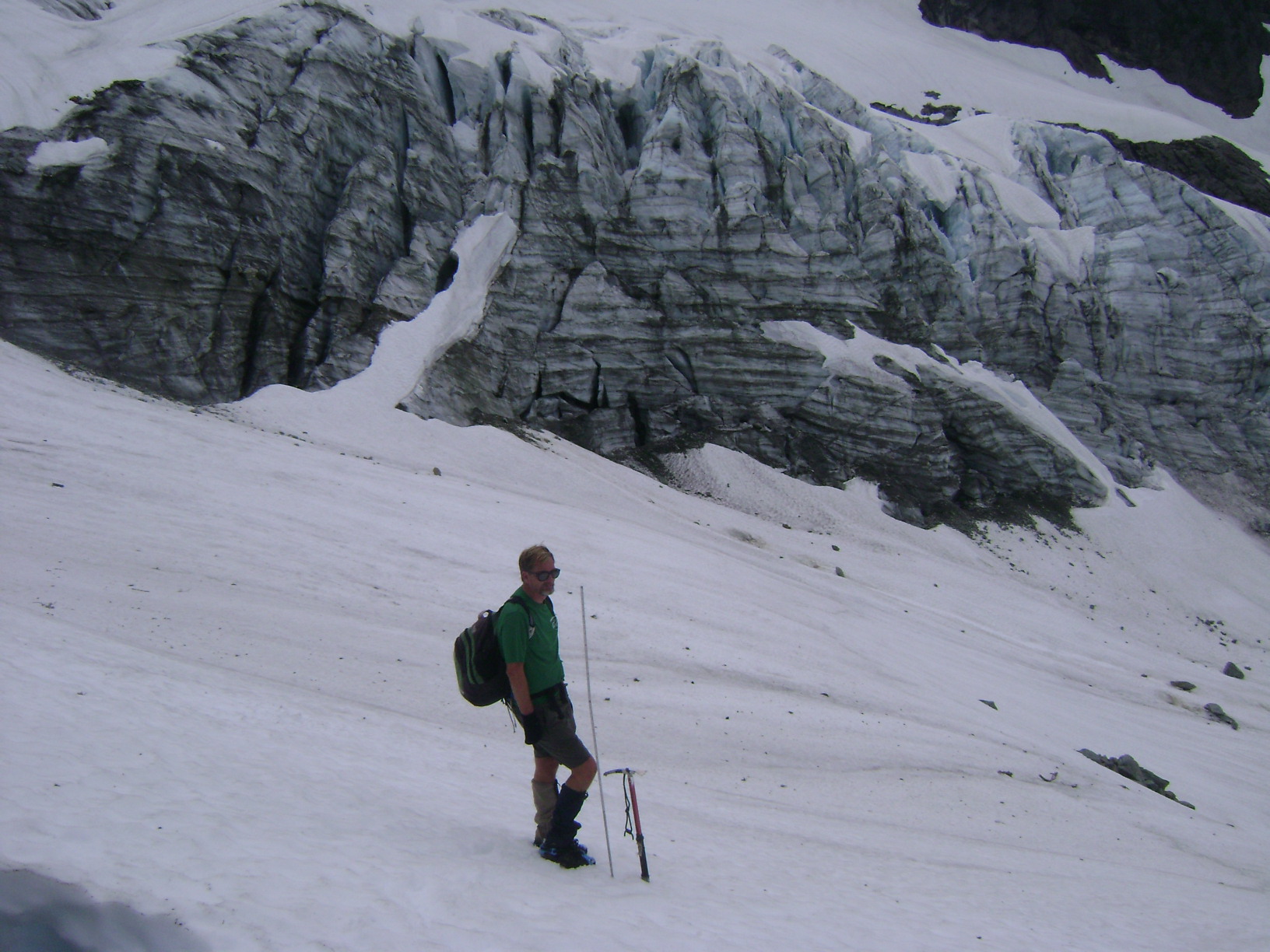August 28, 2011
North Cascade Glacier Climate Project 2011 Field Season Report
Posted by Mauri Pelto
For the 28th consecutive summer the first three weeks of August were spent observing North Cascade glaciers. The 2011 season exhibited unusual snowpack levels second only to 1999 in the last 28 years. In 1999 the world record annual snowfall record was set at Mount Baker, one of our key field research areas. The difference this year was that it was not the winter snowfall that was extraordinary it was the lack of melt through the spring and early summer. A comparison of snowpack at two USDA Snotel long term sites in the North Cascades illustrates that the bright green 2011 on April 1 was ordinary, and that the dark blue 1999 snowpack level was not approached until early June.
 Below is a visual look at the field season in a video followed by detailed description of field results, obtained by Ian Delaney, Mariève Desjardins, Tom Hammond, Ben Pelto, Jill Pelto and Mauri Pelto. [youtube=http://www.youtube.com/watch?v=DghKfVgpDFA]
Below is a visual look at the field season in a video followed by detailed description of field results, obtained by Ian Delaney, Mariève Desjardins, Tom Hammond, Ben Pelto, Jill Pelto and Mauri Pelto. [youtube=http://www.youtube.com/watch?v=DghKfVgpDFA]
The field season began at Columbia Glacier. This is the lowest elevation large glacier in the North Cascades. Enroute to the glacier we probed our way across the still largely frozen Blanca Lake. In the afternoon slush we forded the outlet stream instead. The glacier was 100% snowcovered average snowdepth was just over 5 meters from extensive probing on the glacier. Snow depth in 2009 and 2010 had been nearly identical in early August, this year the depths were consistently 3.8 meters deeper. 
The hike in to Lower Curtis Glacier was on snow as was our camp. A climax avalanche descended from the north side of the valley in two locations enroute to the glacier. The steep terminus of this glacier was exposed. The terminus was easier to explore with snowpack below it, a retreat of 8 meters had occurred since the previous August, all of it late last summer.  The glacier had an average snowpack of just over 5 m, 3.6 meters more than last summer. The next field area was Easton Glacier and Squak Glacier. We measured the snowpack on both. We found 3.5 meters of snowpack at 6000 feet, where normally it is blue ice and at 6600 feet the average snow depth was 4.75 meters. The measurements were almost all made using crevasse stratigraphy as probing more than 4 meters is difficult. Both termini were buried. On
The glacier had an average snowpack of just over 5 m, 3.6 meters more than last summer. The next field area was Easton Glacier and Squak Glacier. We measured the snowpack on both. We found 3.5 meters of snowpack at 6000 feet, where normally it is blue ice and at 6600 feet the average snow depth was 4.75 meters. The measurements were almost all made using crevasse stratigraphy as probing more than 4 meters is difficult. Both termini were buried. On 
 Deming Glacier a new hole had emerged at the base of the icefall on the east side, matching the hole that developed and expanded on the right side (note arrow in top image). We also collected ice worms for an anti-freeze protein project at Queens University, Kingston Ontario (Peter Davies and Mariève Desjardins).
Deming Glacier a new hole had emerged at the base of the icefall on the east side, matching the hole that developed and expanded on the right side (note arrow in top image). We also collected ice worms for an anti-freeze protein project at Queens University, Kingston Ontario (Peter Davies and Mariève Desjardins).
 These anti-freeze proteins help keep organisms from freezing solid, by coalescing around ice crystals and limiting their expansion in part due to lowering the freezing point without altering the melting point. For us they could be a critical resource in surgical transplant procedures where keeping organs cold is important. We could have used some kind of protein to keep us warm on the four chilly-cloudy but dry days on the Easton Glacier. We visited Lyman Glacier ascending the former Spider Glacier valley, which was this summer of course still snow filled. Lyman Glacier has lost some of its splendor in the last three years. It had a high ice cliff in 2008 and 2009, measured at 18 meters that has now diminished to 8 meters The glacier has gone from an average surface slope of 12 degrees in 1986 to 18 degrees in 2008 to 21 degrees in 2011, as it continues a rapid ice loss. The steepening results from more rapid thinning at the terminus and overall glacier shortening as the 10 meter per year retreat continues. On Mount Daniels snowpack was not as extraordinary as at other locations. Snowpack on Ice Worm Glacier averaged 4.6 meters, and on Lynch and Daniels Glacier 4.3 and 4.6 meters respectively, this was 2.5 meters more than average. This area had significantly less above average snowfall than the other field areas. Pea Soup Lake at the base of Lynch was still ice covered. We ascended the Lynch over the bergshrund pictured in last image below with a snow depth from the winter of 6.7 meters.
These anti-freeze proteins help keep organisms from freezing solid, by coalescing around ice crystals and limiting their expansion in part due to lowering the freezing point without altering the melting point. For us they could be a critical resource in surgical transplant procedures where keeping organs cold is important. We could have used some kind of protein to keep us warm on the four chilly-cloudy but dry days on the Easton Glacier. We visited Lyman Glacier ascending the former Spider Glacier valley, which was this summer of course still snow filled. Lyman Glacier has lost some of its splendor in the last three years. It had a high ice cliff in 2008 and 2009, measured at 18 meters that has now diminished to 8 meters The glacier has gone from an average surface slope of 12 degrees in 1986 to 18 degrees in 2008 to 21 degrees in 2011, as it continues a rapid ice loss. The steepening results from more rapid thinning at the terminus and overall glacier shortening as the 10 meter per year retreat continues. On Mount Daniels snowpack was not as extraordinary as at other locations. Snowpack on Ice Worm Glacier averaged 4.6 meters, and on Lynch and Daniels Glacier 4.3 and 4.6 meters respectively, this was 2.5 meters more than average. This area had significantly less above average snowfall than the other field areas. Pea Soup Lake at the base of Lynch was still ice covered. We ascended the Lynch over the bergshrund pictured in last image below with a snow depth from the winter of 6.7 meters. .
.
The mass balance of North Cascade glaciers will be strongly positive in 2011. We normally take 1100-1300 snow depth measurements. This year the deeper snowpack limited out measurements to 1/3 this total. Each glacier will be checked again in one month, to assess the final mass balance.


 Dean of Academic Affairs at Nichols College and Professor of Environmental Science at Nichols College in Massachusetts since 1989. Glaciologist directing the North Cascade Glacier Climate Project since 1984. This project monitors the mass balance and behavior of more glaciers than any other in North America.
Dean of Academic Affairs at Nichols College and Professor of Environmental Science at Nichols College in Massachusetts since 1989. Glaciologist directing the North Cascade Glacier Climate Project since 1984. This project monitors the mass balance and behavior of more glaciers than any other in North America.